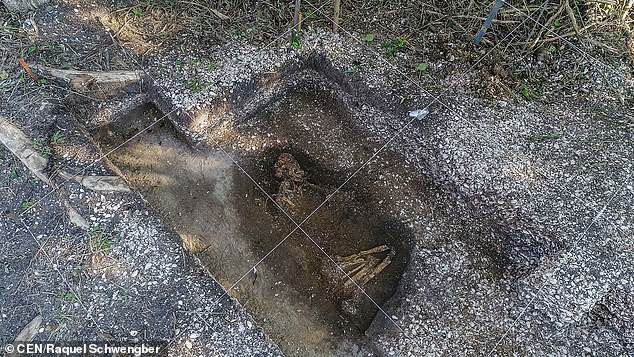Detecting intact 6,000-year-old skeleton under construction site
Two human skeletons from 6,000 years ago were preserved very well and the teeth remained intact suddenly exposed at a construction site in Brazil.
The skeleton was found on the BR-470 road in Ilhota municipality in the state of Santa Catarina. The skull and legs are perfectly preserved and the teeth are almost intact.

Ancient skeleton found under construction site.
It is thought that the area used to be an island between the lagoon and the habitat of the ancient people. Scientists say the two skeletons are most likely members of one of the hundreds of Jiquabu tribes that used to live in Brazil between 10,000 years ago and colonial times.
The skeleton was found during the road expansion in May last. Beta Analytics Laboratory in Florida, USA, then received the skeleton and identified them dating from 5,880 years ago.
Archaeologist Valdir Luiz Schwengber at the University of Southern Santa Catarina leads the excavation process. He said the skeleton is only 60cm from the ground. In ancient times, this must be an extremely isolated island with no drinking water.
Scientists believe the area used to be a funeral place.
"Collected data shows that the ancient people here eat fish such as catfish, snapper and flounder," Valdir said. " The small size of fish shows that the main food supply is young fish in shallow water".
When Portuguese explorers arrived in Brazil, it was home to hundreds of Jiquabu tribes. The earliest clues found 10,000 years ago in the Minas Gerais plateau. Many experts believe these tribes are part of a wave of hunters migrating from Asia to the Americas through the Bering Strait.
There is very little information because these cultures do not have written records or permanent agricultural imprints. By the time people found Europe, Brazil had 2,000 semi-nomadic tribes.
A Tuburao lab is currently hosting and studying the skeleton. A group of multidisciplinary researchers from fields such as biology, history and archeology are involved in the research process.

The teeth are almost intact.
"This study will help us better understand the process of occupying the current coast of Santa Catarina , " Valdir said.
People have fenced off the skeleton area found and may turn this place into an educational site.
A study earlier this year found that the areas of Amazon that once thought there were no people were actually the home of a million people 1250 years ago.
Archaeologists discovered many evidence that there were 1,500 villages in the tropical rainforest and away from the big rivers. Two-thirds of them have yet to be found. The lives of these indigenous people were completely destroyed when European settlers arrived and brought with them the plague.
- 'Treasures' and thousands of years of comedy appear at the construction site
- See the most intact skeleton of human ancestors
- The 1,300-year-old twisted skeleton made the archeology confused
- Detecting the remains of 'hug each other without leaving' for 6,000 years
- The 3,200-year-old sword is intact under rock
- Video: Robot builds walls 6 times faster than masons
- Roman city 2,000 years under construction site
- Build houses, dig ancient towns 2,000 years
- Detecting intact mammoth corpses in the North Pole
- Discovered a 3,500-year-old male and female skeleton in the fist position
- The pastor shows the face of a man who died 10,000 years ago
- Detecting homosexual people
 Discovered an ancient centipede fossil 99 million years old
Discovered an ancient centipede fossil 99 million years old Discovered bat-like dinosaurs in China
Discovered bat-like dinosaurs in China Discovered a 200-year-old bronze cannon of the coast
Discovered a 200-year-old bronze cannon of the coast Discover 305 million-year-old spider fossils
Discover 305 million-year-old spider fossils